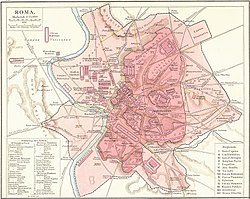 The Amphitheatrum Castrense | |
 Click on the map for a fullscreen view | |
| Location | Rome |
|---|---|
| Coordinates | 41°53′15″N12°30′54″E / 41.88750°N 12.51500°E |
| History | |
| Material | Wood |
The Amphitheatrum Castrense is a Roman amphitheatre in Rome, next to the church of Santa Croce in Gerusalemme. [1] Both the Amphiteatrum and the Circus Varianus were part of the palatial villa known as the Horti Spei Veteris and later the Palatium Sessorium. The Regionary Catalogues name it as the "Amphitheatrum Castrense", which could mean it was an amphitheatre connected to an imperial residence. [2]

